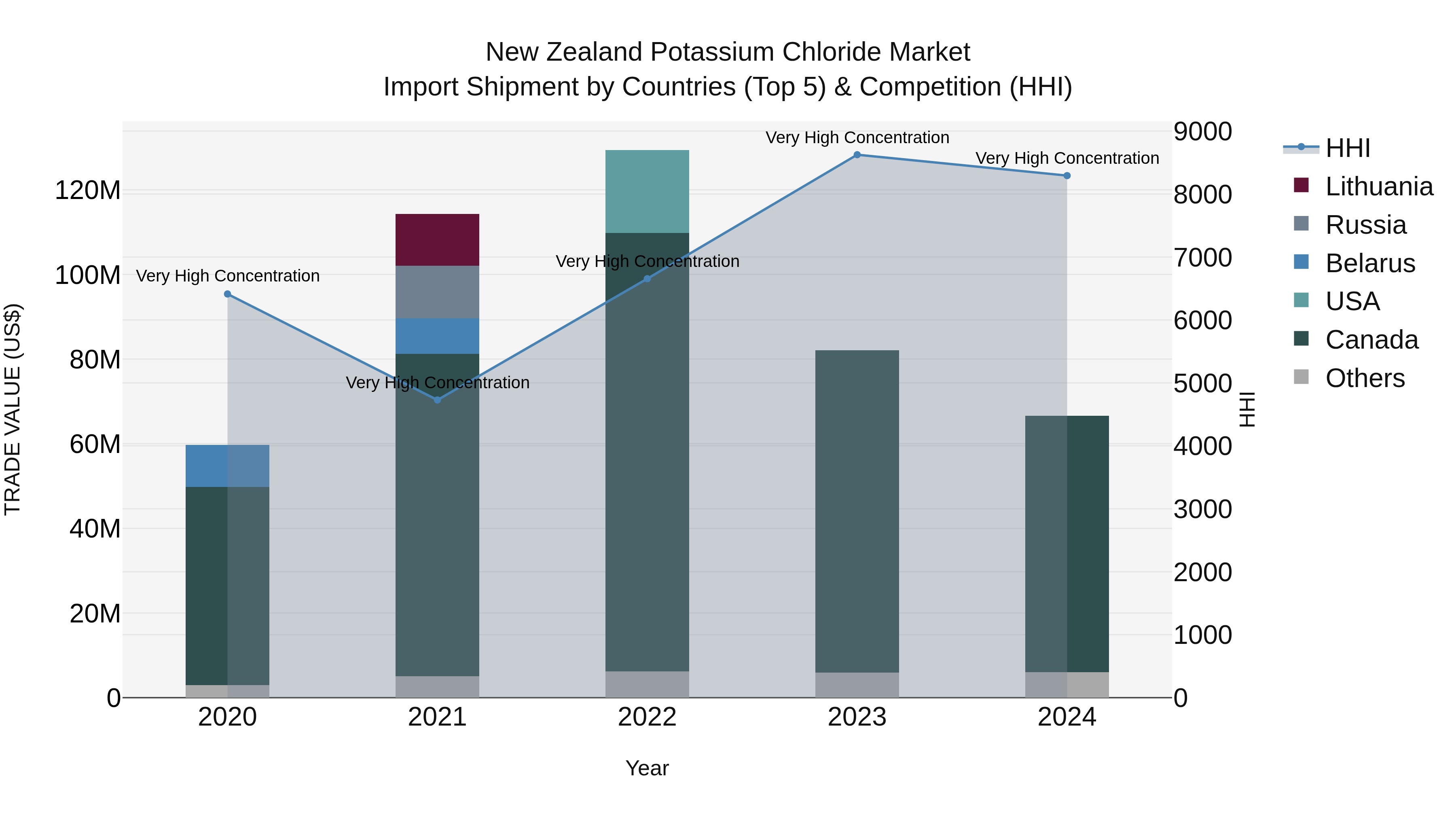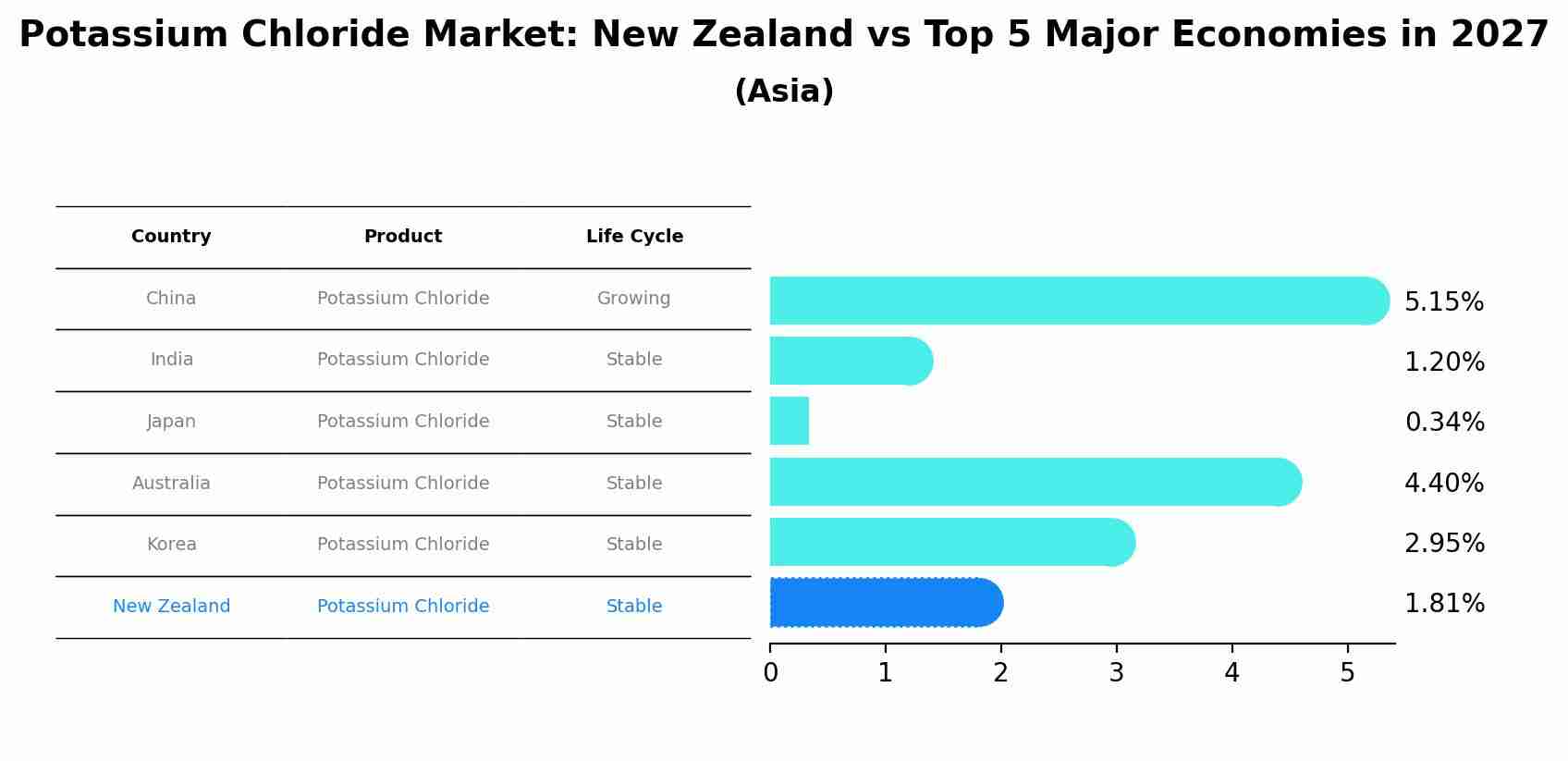New Zealand Potassium Chloride Market (2025-2031) | Size, Segmentation, Companies, Industry, Outlook, Share, Growth, Trends, Analysis, Value, Forecast & Revenue
| Product Code: ETC4856440 | Publication Date: Nov 2023 | Updated Date: Nov 2025 | Product Type: Market Research Report | |
| Publisher: 6Wresearch | Author: Sachin Kumar Rai | No. of Pages: 60 | No. of Figures: 30 | No. of Tables: 5 |
New Zealand Potassium Chloride Market Top 5 Importing Countries and Market Competition (HHI) Analysis
New Zealand`s potassium chloride import market in 2024 saw a high level of concentration, with top exporting countries being Canada, Germany, Lao People`s Dem. Rep., Israel, and Vietnam. Despite the challenging economic conditions, the market experienced a modest compound annual growth rate (CAGR) of 2.76% from 2020 to 2024. However, there was a notable decline in growth rate from 2023 to 2024 at -18.84%. This data suggests a mix of stability and challenges in the New Zealand potassium chloride import market, with potential opportunities for further analysis and strategic decision-making.

Potassium Chloride Market: New Zealand vs Top 5 Major Economies in 2027 (Asia)
The Potassium Chloride market in New Zealand is projected to grow at a stable growth rate of 1.81% by 2027, within the Asia region led by China, along with other countries like India, Japan, Australia and South Korea, collectively shaping a dynamic and evolving market environment driven by innovation and increasing adoption of emerging technologies.

New Zealand Potassium Chloride Market Overview
The Potassium Chloride market in New Zealand is witnessing steady growth, supported by its extensive use in agriculture, chemical manufacturing, and healthcare sectors. Potassium chloride, a vital source of potassium for plants and a key ingredient in chemical production, is in high demand due to its role in enhancing crop yield, manufacturing fertilizers, and producing pharmaceutical formulations. With a focus on sustainable agricultural practices and nutrient management, farmers and industries in New Zealand are increasingly adopting potassium chloride-based solutions. Market participants offer a wide range of potassium chloride products, including granular, powder, and liquid formulations, catering to diverse end-user requirements.
Drivers of the market
The potassium chloride market in New Zealand is driven by its widespread applications in agriculture, chemical manufacturing, and pharmaceuticals. Potassium chloride is a primary source of potassium fertilizer, essential for plant nutrition and crop yield optimization. The increasing demand for high-quality agricultural produce, coupled with the need for efficient nutrient management, is driving market growth. Moreover, potassium chloride is used in various chemical processes, including water treatment and food processing, further expanding its market potential. Additionally, the pharmaceutical industry`s demand for potassium chloride in the formulation of medications and dietary supplements is contributing to market expansion.
Challenges of the market
Challenges in the Potassium Hydroxide market include handling and storage safety, product purity, and regulatory compliance. Meeting diverse industrial and consumer demands while minimizing environmental impact requires continuous innovation in manufacturing processes and applications.
Government Policy of the market
Government regulations in New Zealand govern the potassium chloride market to ensure safe handling, storage, and usage in various industries, including agriculture, food processing, and chemical manufacturing. The Ministry of Health sets standards for potassium chloride additives in food products to protect consumer health and prevent excessive intake.
Key Highlights of the Report:
- New Zealand Potassium Chloride Market Outlook
- Market Size of New Zealand Potassium Chloride Market, 2024
- Forecast of New Zealand Potassium Chloride Market, 2031
- Historical Data and Forecast of New Zealand Potassium Chloride Revenues & Volume for the Period 2021-2031
- New Zealand Potassium Chloride Market Trend Evolution
- New Zealand Potassium Chloride Market Drivers and Challenges
- New Zealand Potassium Chloride Price Trends
- New Zealand Potassium Chloride Porter`s Five Forces
- New Zealand Potassium Chloride Industry Life Cycle
- Historical Data and Forecast of New Zealand Potassium Chloride Market Revenues & Volume By Application for the Period 2021-2031
- Historical Data and Forecast of New Zealand Potassium Chloride Market Revenues & Volume By Fertilizer for the Period 2021-2031
- Historical Data and Forecast of New Zealand Potassium Chloride Market Revenues & Volume By Pharmaceutical for the Period 2021-2031
- Historical Data and Forecast of New Zealand Potassium Chloride Market Revenues & Volume By Industrial for the Period 2021-2031
- Historical Data and Forecast of New Zealand Potassium Chloride Market Revenues & Volume By Food for the Period 2021-2031
- New Zealand Potassium Chloride Import Export Trade Statistics
- Market Opportunity Assessment By Application
- New Zealand Potassium Chloride Top Companies Market Share
- New Zealand Potassium Chloride Competitive Benchmarking By Technical and Operational Parameters
- New Zealand Potassium Chloride Company Profiles
- New Zealand Potassium Chloride Key Strategic Recommendations
Frequently Asked Questions About the Market Study (FAQs):
1 Executive Summary |
2 Introduction |
2.1 Key Highlights of the Report |
2.2 Report Description |
2.3 Market Scope & Segmentation |
2.4 Research Methodology |
2.5 Assumptions |
3 New Zealand Potassium Chloride Market Overview |
3.1 New Zealand Country Macro Economic Indicators |
3.2 New Zealand Potassium Chloride Market Revenues & Volume, 2021 & 2031F |
3.3 New Zealand Potassium Chloride Market - Industry Life Cycle |
3.4 New Zealand Potassium Chloride Market - Porter's Five Forces |
3.5 New Zealand Potassium Chloride Market Revenues & Volume Share, By Application, 2021 & 2031F |
4 New Zealand Potassium Chloride Market Dynamics |
4.1 Impact Analysis |
4.2 Market Drivers |
4.2.1 Increasing demand for potassium chloride in agriculture sector due to its role in enhancing crop yield and quality. |
4.2.2 Growing awareness about the benefits of potassium chloride in improving soil health and plant nutrition. |
4.2.3 Government initiatives promoting sustainable agricultural practices and use of potassium chloride. |
4.3 Market Restraints |
4.3.1 Fluctuating prices of potassium chloride in the global market impacting the affordability for local farmers. |
4.3.2 Environmental concerns related to excessive use of potassium chloride leading to soil degradation. |
4.3.3 Competition from alternative potassium fertilizers and substitutes affecting market penetration. |
5 New Zealand Potassium Chloride Market Trends |
6 New Zealand Potassium Chloride Market Segmentations |
6.1 New Zealand Potassium Chloride Market, By Application |
6.1.1 Overview and Analysis |
6.1.2 New Zealand Potassium Chloride Market Revenues & Volume, By Fertilizer, 2021-2031F |
6.1.3 New Zealand Potassium Chloride Market Revenues & Volume, By Pharmaceutical, 2021-2031F |
6.1.4 New Zealand Potassium Chloride Market Revenues & Volume, By Industrial, 2021-2031F |
6.1.5 New Zealand Potassium Chloride Market Revenues & Volume, By Food, 2021-2031F |
7 New Zealand Potassium Chloride Market Import-Export Trade Statistics |
7.1 New Zealand Potassium Chloride Market Export to Major Countries |
7.2 New Zealand Potassium Chloride Market Imports from Major Countries |
8 New Zealand Potassium Chloride Market Key Performance Indicators |
8.1 Average selling price of potassium chloride in New Zealand market. |
8.2 Adoption rate of potassium chloride in different agricultural regions. |
8.3 Number of research studies and trials validating the efficacy of potassium chloride in improving crop productivity. |
9 New Zealand Potassium Chloride Market - Opportunity Assessment |
9.1 New Zealand Potassium Chloride Market Opportunity Assessment, By Application, 2021 & 2031F |
10 New Zealand Potassium Chloride Market - Competitive Landscape |
10.1 New Zealand Potassium Chloride Market Revenue Share, By Companies, 2024 |
10.2 New Zealand Potassium Chloride Market Competitive Benchmarking, By Operating and Technical Parameters |
11 Company Profiles |
12 Recommendations | 13 Disclaimer |
- Single User License$ 1,995
- Department License$ 2,400
- Site License$ 3,120
- Global License$ 3,795
Search
Thought Leadership and Analyst Meet
Our Clients
Related Reports
- Canada Oil and Gas Market (2026-2032) | Share, Segmentation, Value, Industry, Trends, Forecast, Analysis, Size & Revenue, Growth, Competitive Landscape, Outlook, Companies
- Germany Breakfast Food Market (2026-2032) | Industry, Share, Growth, Size, Companies, Value, Analysis, Revenue, Trends, Forecast & Outlook
- Australia Briquette Market (2025-2031) | Growth, Size, Revenue, Forecast, Analysis, Trends, Value, Share, Industry & Companies
- Vietnam System Integrator Market (2025-2031) | Size, Companies, Analysis, Industry, Value, Forecast, Growth, Trends, Revenue & Share
- ASEAN and Thailand Brain Health Supplements Market (2025-2031) | Strategy, Consumer Insights, Analysis, Investment Trends, Opportunities, Growth, Size, Share, Industry, Revenue, Segments, Value, Segmentation, Supply, Forecast, Restraints, Outlook, Competition, Drivers, Trends, Demand, Pricing Analysis, Competitive, Strategic Insights, Companies, Challenges
- ASEAN Bearings Market (2025-2031) | Strategy, Consumer Insights, Analysis, Investment Trends, Opportunities, Growth, Size, Share, Industry, Revenue, Segments, Value, Segmentation, Supply, Forecast, Restraints, Outlook, Competition, Drivers, Trends, Demand, Pricing Analysis, Competitive, Strategic Insights, Companies, Challenges
- Europe Flooring Market (2025-2031) | Outlook, Share, Industry, Trends, Forecast, Companies, Revenue, Size, Analysis, Growth & Value
- Saudi Arabia Manlift Market (2025-2031) | Outlook, Size, Growth, Trends, Companies, Industry, Revenue, Value, Share, Forecast & Analysis
- Uganda Excavator, Crane, and Wheel Loaders Market (2025-2031) | Strategy, Consumer Insights, Analysis, Investment Trends, Opportunities, Growth, Size, Share, Industry, Revenue, Segments, Value, Segmentation, Supply, Forecast, Restraints, Outlook, Competition, Drivers, Trends, Demand, Pricing Analysis, Competitive, Strategic Insights, Companies, Challenges
- Rwanda Excavator, Crane, and Wheel Loaders Market (2025-2031) | Strategy, Consumer Insights, Analysis, Investment Trends, Opportunities, Growth, Size, Share, Industry, Revenue, Segments, Value, Segmentation, Supply, Forecast, Restraints, Outlook, Competition, Drivers, Trends, Demand, Pricing Analysis, Competitive, Strategic Insights, Companies, Challenges
Industry Events and Analyst Meet
Whitepaper
- Middle East & Africa Commercial Security Market Click here to view more.
- Middle East & Africa Fire Safety Systems & Equipment Market Click here to view more.
- GCC Drone Market Click here to view more.
- Middle East Lighting Fixture Market Click here to view more.
- GCC Physical & Perimeter Security Market Click here to view more.
6WResearch In News
- Doha a strategic location for EV manufacturing hub: IPA Qatar
- Demand for luxury TVs surging in the GCC, says Samsung
- Empowering Growth: The Thriving Journey of Bangladesh’s Cable Industry
- Demand for luxury TVs surging in the GCC, says Samsung
- Video call with a traditional healer? Once unthinkable, it’s now common in South Africa
- Intelligent Buildings To Smooth GCC’s Path To Net Zero


















